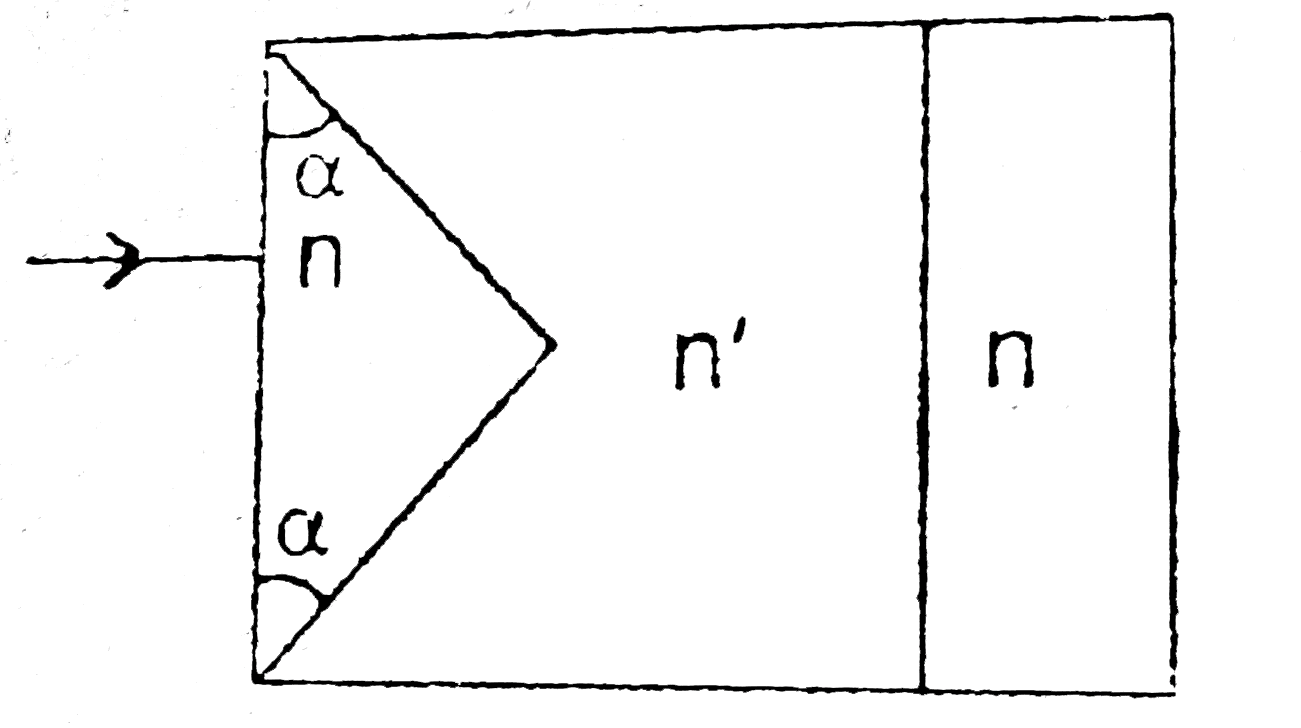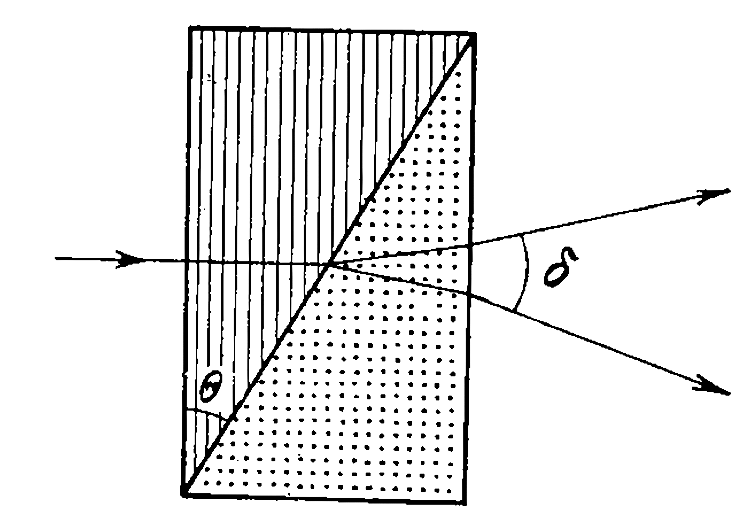A palne light wave with wavelength falls normally on the base of a biprism made of glass with refracting angle . Behind the biprism (Fig.) there is a plane-parallel plate, with the space between them filled up with benzence . Find the width of a fringe on the screen placed behind this system.

It will be assumed that the space between the biprism and the glass plate filled with benzene consitiutes complementary prism as shown.
Then the two prism being oppositely placed, the net deviation produced by them is
Hence as in the pervious problem
So
For plane incident wave we let
so .

Topper's Solved these Questions
- BOOK - IE IRODOV, LA SENA & SS KROTOVCHAPTER - OPTICSEXERCISE - Diffraction Of Light60videos
OPTICS
- BOOK - IE IRODOV, LA SENA & SS KROTOVCHAPTER - OPTICSEXERCISE - Polarization Of Light43videos
OPTICS
- BOOK - IE IRODOV, LA SENA & SS KROTOVCHAPTER - OPTICSEXERCISE - Exercise2videos
OPTICS
- BOOK - IE IRODOV, LA SENA & SS KROTOVCHAPTER - MECHANICSEXERCISE - Mechanics Problems92videos
MECHANICS
- BOOK - IE IRODOV, LA SENA & SS KROTOVCHAPTER - OSCILLATIONS AND WAVESEXERCISE - Electromagnetic Waves, Radiation36videos
OSCILLATIONS AND WAVES
Similar Questions
A plane light wave of wavelength λ=700nm falls normally on the base of a biprism made of glass (μ=1.560) width refracting angle θ=5∘. A plate is placed behind the biprism and the space between them is filled with a liquid of refractive index (μ'=1.500). Find the fringe width on a screen behind the biprism.
 View Solution
View SolutionA plane light wave with wavelength λ=0.60μm falls normally on the face of a glass wedge with refracting angle Θ=15∘. The opposite face of the wedge is opaque and has a slit of width b=10μm parallel to the edge. Final:
(a) the angle Δθbetween the direction to the Fqaunhofer maximum of zeroth order and that of incident light,
(b) the angular width of the frqunhofer maximum of the zeroth order.View SolutionA beam of light is incident on a system as shown in the figure. Behind the prism there is a plane parallel plate, with the space between filled up with benzene (R.I = n'). Find the deviation in the emergent beam w.r.t incident beam in terms of α,n,n'. Assume α = small angle [Take both cases n>n'&n'>n]
 View Solution
View SolutionA plane light wave with wavelength λ=0.50μm falls normally on the face of a glass wedge with an angle Θ=30∘. On the opposite face of the wedge a transparent diffraction grating with period, d=2.00μm is inscibed, whose lines are parallel to the wedge's edge. Find the angles that the direction of incident light froms with the directions to the principle Fraunhofer maxima of the zero and the first order. waht is the highest order of the spectrum? At what angle to the direction of incident light of the observed?
View SolutionA plane light wave with wavelength λ=0.65μm falls normally on a large glass plate whose opposite side has a large and an opaque strip of width a=0.30mm (Fig.) A screen is placed at a distance b=110cm from the plate. The height h of the ledge is such that the intensity of light at point 2 of the screen is the heighest possible. making use of Fig. find the ratio of intensities at point 1 and 2.

 View Solution
View SolutionLight with wavelength λ=0.50μm falls on a slit of width b=10μm at an angle θ0=30∘ to its normal. Find the angular position of the first minima located on both sides of the central Fraunhofer maximum.
View SolutionA plane light wave with wavelength λ=0.60μm falls normally on a sufficiently large glass plate having a round recess on the oppiste side (Fig.) For the observation point P that recess correcponds to the first one and and a half Fresnel zones. Find the depth h of the recess at which the intensity of light at the point P is
(a) maximum,
(b) minimum,
(c ) equal to the intensity of incident light.
 View Solution
View SolutionA plane light wave falls on Fresnel mirrors with an angle α=2.0 between them. Determine the wavelength of light if the width of the fringe on the screen Δx=0.55mm.
View SolutionA narrow beam of natural light with wavelength λ=589nm falls normally on the surface of a Wollaston polarizing prism made of Iceland spar as shown in Fig. The optical axes of the two parts of the prism are mutually perpendicualr. Find the angle δ between the directions of the beams behind the prism if the angle θ is equal to 30∘.
 View Solution
View SolutionA plane light wave with wavelength λ=0.65μm falls normally on a large glass plate whose opposite side has a longrectangular recess 0.60mm wide. Using Fig. find the depth H of the recess at which the diffraction pattern on the screen 77cm away from the plate has the maximum illuminance at its centre.
 View Solution
View Solution

